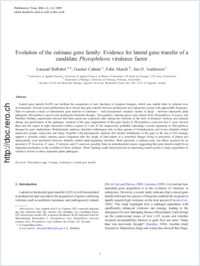Evolution of the cutinase gene family: Evidence for lateral gene transfer of a candidate Phytophthora virulence factor
- Belbahri, Lassaad Laboratory of Applied Genetics, University of Applied Sciences of Western Switzerland, Jussy, Switzerland
- Calmin, Gautier Laboratory of Applied Genetics, University of Applied Sciences of Western Switzerland, Jussy, Switzerland
- Mauch, Felix Department of Biology, University of Fribourg, Switzerland
- Andersson, Jan O. Institute of Cell and Molecular Biology, Uppsala University, Sweden
-
23.10.2007
Published in:
- Gene. - 2008, vol. 408, no. 1-2, p. 1-8
English
Lateral gene transfer (LGT) can facilitate the acquisition of new functions in recipient lineages, which may enable them to colonize new environments. Several recent publications have shown that gene transfer between prokaryotes and eukaryotes occurs with appreciable frequency. Here we present a study of interdomain gene transfer of cutinases – well documented virulence factors in fungi – between eukaryotic plant pathogens Phytophthora species and prokaryotic bacterial lineages. Two putative cutinase genes were cloned from Phytophthora brassicae and Northern blotting experiments showed that these genes are expressed early during the infection of the host Arabidopsis thaliana and induced during cyst germination of the pathogen. Analysis of the gene organisation of this gene family in Phytophthora ramorum and P. sojae showed three and ten copies in tight succession within a region of 5 and 25 kb, respectively, probably indicating a recent expansion in Phytophthora lineages by gene duplications. Bioinformatic analyses identified orthologues only in three genera of Actinobacteria, and in two distantly related eukaryotic groups: oomycetes and fungi. Together with phylogenetic analyses this limited distribution of the gene in the tree of life strongly support a scenario where cutinase genes originated after the origin of land plants in a microbial lineage living in proximity of plants and subsequently were transferred between distantly related plant-degrading microbes. More precisely, a cutinase gene was likely acquired by an ancestor of P. brassicae, P. sojae, P. infestans and P. ramorum, possibly from an actinobacterial source, suggesting that gene transfer might be an important mechanism in the evolution of their virulence. These findings could indeed provide an interesting model system to study acquisition of virulence factors in these important plant pathogens.
- Faculty
- Faculté des sciences et de médecine
- Department
- Département de Biologie
- Language
-
- English
- Classification
- Biological sciences
- License
-
License undefined
- Identifiers
-
- RERO DOC 8840
- DOI 10.1016/j.gene.2007.10.019
- Persistent URL
- https://folia.unifr.ch/unifr/documents/300618
Statistics
Document views: 168
File downloads:
- pdf: 314
